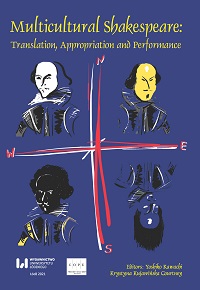Facial Recognition and Posthuman Technologies in Shakespeare’s Sonnets
DOI:
https://doi.org/10.18778/2083-8530.24.10Keywords:
Shakespeare’s sonnets, facial recognition, Dark Lady, fair youth, Nature, Time, posthumanism, biometrics, face, Woody BledsoeAbstract
The human face, real and imagined, has long figured into various forms of cultural and personal recognition—to include citizenship, in both the modern and the ancient world. But beyond affiliations related to borders and government, the human face has also figured prominently into biometrics that feed posthuman questions and anxieties. For while one requirement of biometrics is concerned with “unicity,” or that which identifies an individual as unique, another requirement is that it identify “universality,” confirming an individual’s membership in the species. Shakespeare’s sonnets grapple with the crisis of encountering a universal beauty in a unique specimen to which Time and Nature nonetheless afford no special privilege. Between fair and dark lies a posthuman lament over the injustice of natural law and the social valorizations arbitrarily marshaled to defend it.
Downloads
References
Agamben, Giorgio. Homo Sacer: Sovereign Power and Bare Life. Trans. Daniel Heller-Roazen. Stanford: Stanford UP, 1998.
Google Scholar
Agamben, Giorgio. “No to Bio-Political Tattooing.” Le Monde 10 January 2004.
Google Scholar
Agamben, Giorgio. States of Exception. Trans. Kevin Attell. Chicago: U of Chicago P, 2005.
Google Scholar
DOI: https://doi.org/10.7208/chicago/9780226009261.001.0001
Bledsoe, Woody. “I Had a Dream: AAAI Presidential Address, 19 August 1985.” AI Magazine 7.1 (1986): 57-61 https://doi.org/10.1002/j.1834-4461.1986.tb02176.x
Google Scholar
DOI: https://doi.org/10.1002/j.1834-4461.1986.tb02176.x
“A Brief History of Facial Recognition.” 26 May 2020. NEC: Orchestrating a Brighter World https://www.nec.co.nz/market-leadership/publications-media/a-briefhistory-of-facial-recognition/ Accessed 5 July 2021.
Google Scholar
Campana, Joseph, and Scott Maisano, eds. Renaissance Posthumanism. New York: Fordham, 2016.
Google Scholar
DOI: https://doi.org/10.5422/fordham/9780823269556.001.0001
Colebrook, Claire. Death of the Posthuman: Essays on Extinction, Vol. 1. Ann Arbor, MI: Open Humanities Press, 2014 https://doi.org/10.3998/ohp.12329362.0001.001 Accessed 15 July 2021.
Google Scholar
DOI: https://doi.org/10.3998/ohp.12329362.0001.001
Deleuze, Gilles, and Félix Guattari. “Year Zero: Faciality.” A Thousand Plateaus: Capitalism and Schizophrenia. Trans. by Brian Massumi, 167-91. Minneapolis: U of Minnesota P, 1987.
Google Scholar
Foucault, Michel. Dits et écrits. Vols. 3-4. Paris: Gallimard, 1994.
Google Scholar
Hokama, Rhema. “Love’s Rites: Performing Prayer in Shakespeare’s Sonnets.” Shakespeare Quarterly 63.2 (2012): 199-223 https://doi.org/10.1353/shq.2012.0032
Google Scholar
DOI: https://doi.org/10.1353/shq.2012.0032
King, Martin Luther, Jr. “I Have a Dream.” 28 August 1963. NPR. 18 January 2010 https://www.npr.org/2010/01/18/122701268/i-have-a-dream-speech-in-its-entirety Accessed 15 July 2021.
Google Scholar
Knapp, James A., ed. Shakespeare and the Power of the Face. 2015. London: Routledge, 2019 https://doi.org/10.4324/9781315608655
Google Scholar
DOI: https://doi.org/10.4324/9781315608655
Latour, Bruno. “An Attempt at a ‘Compositionist Manifesto.’” New Literary History 41.3 (2010): 471-90.
Google Scholar
Latour, Bruno. We Have Never Been Modern. Trans. Catherine Porter. Cambridge, MA: Harvard UP, 1993.
Google Scholar
Levinas, Emmanuel. “The Face.” In Ethics and Infinity, trans. Richard A. Cohen, Pittsburgh: Duquesne UP, 1985. 83-92.
Google Scholar
Liggett, John. The Human Face. New York: Stein & Day, 1974.
Google Scholar
Loh, Maria H. “Renaissance Faciality.” Oxford Art Journal 32.3 (2009): 341-63 https://doi.org/10.1093/oxartj/kcp032
Google Scholar
DOI: https://doi.org/10.1093/oxartj/kcp032
McCoy, Richard C. “Love’s Martyrs: Shakespeare’s ‘Turtle and Phoenix’ and the Sacrificial Sonnets.” Religion and Culture in Renaissance England, eds. Claire McEachern and Debora Shuger, Cambridge: Cambridge UP, 1997. 188-208.
Google Scholar
Mordini, Emilio, and Sonia Massari. “Body, Biometrics and Identity.” Bioethics 22.9 (2008): 488-98.
Google Scholar
DOI: https://doi.org/10.1111/j.1467-8519.2008.00700.x
Nardizzi, Vin. “Shakespeare’s Penknife: Grafting and Seedless Generation in the Procreation Sonnets.” Renaissance and Reformation 32.1 (2009): 83-106 https://doi.org/10.33137/rr.v32i1.9591
Google Scholar
DOI: https://doi.org/10.33137/rr.v32i1.9591
Perkowitz, Sidney. “The Bias in the Machine: Facial Recognition Technology and Racial Disparities.” MIT Case Studies in Social and Ethical Responsibilities of Computing https://doi.org/10.21428/2c646de5.62272586. 5 February 2021 15 July 2021.
Google Scholar
DOI: https://doi.org/10.21428/2c646de5.62272586
Raber, Karen. Shakespeare and Posthumanist Theory. Arden: London, 2018.
Google Scholar
Raviv, Shaun. “The Secret History of Facial Recognition.” Wired 28.2 (February 2020) https://www.wired.com/story/secret-history-facial-recognition/ Accessed 19 July 2021.
Google Scholar
Rogers, Mary. Review of Renaissance Self-Portraiture: The Visual Construction of Identity and the Social Status of the Artist, by Joanna Woods-Marsden, and The Image of the Individual: Portraits in the Renaissance, by Nicholas Mann and Luke Syson, eds. Renaissance Studies 14.3 (2000): 375-78.
Google Scholar
Schmitt, Carl. Political Theology. Trans. George Schwab. Cambridge: MIT Press, 1985.
Google Scholar
Seamon, John G. “Dynamic Facial Recognition: Examination of a Natural Phenomenon.” American Journal of Psychology 95.3 (1982): 363-81 https://doi.org/10.2307/1422130
Google Scholar
DOI: https://doi.org/10.2307/1422130
Shakespeare, William. The Sonnets. Norton Shakespeare. Ed. Stephen Greenblatt, et al., 3rd ed. New York: Norton, 2016. 2241-303.
Google Scholar
Shannon, Laurie. “Poor, Bare Forked: Animal Sovereignty, Human Negative Exceptionalism, and the Natural History of King Lear.” Shakespeare Quarterly 60.2 (2009): 168-96.
Google Scholar
DOI: https://doi.org/10.1353/shq.0.0076
Sorel, Charles. The Extravagant Shepherd. Translated by John Davies. London: Newcomb, 1654.
Google Scholar
Swarbrick, Steven, and Karen Raber. “Introduction: Renaissance Posthumanism and Its Afterlives.” Criticism 62.3 (2020): 313-28 https://doi.org/10.13110/criticism.62.3.0313
Google Scholar
DOI: https://doi.org/10.13110/criticism.62.3.0313
Taylor-Alexander, Samuel. “How the Face Became an Organ.” Somatosphere: Science, Medicine, and Anthropology. 11 August 2014 http://somatosphere.net/2014/how-the-face-became-an-organ.html/ Accessed 15 July 2021.
Google Scholar
Tsui, Jenna. “Why Gender Neutral Facial Recognition Will Change How We Look at Technology.” https://www.technologynetworks.com/informatics/articles/whygender-neutral-facial-recognition-will-change-how-we-look-at-technology-332962 Accessed 15 July 2021.
Google Scholar
Tyson, Neil deGrasse. “A Mind-Expanding Tour of the Cosmos with Neil deGrasse Tyson and Robert Krulwich.” 92nd Street Y. 92YOnDemand.org. 10 May 2017. YouTube https://youtube.com/watch?v=AyAK3QBnMGQ Accessed 15 July 2021.
Google Scholar
Williams, Damien Patrick. “Fitting the Description: Historical and Sociotechnical Elements of Facial Recognition and Anti-Black Surveillance.” Journal of Responsible Innovation 7, sup. 1: 74-83 https://doi.org/10.1080/23299460.2020.1831365 Accessed 15 July 2021.
Google Scholar
DOI: https://doi.org/10.1080/23299460.2020.1831365
Downloads
Published
How to Cite
Issue
Section
License

This work is licensed under a Creative Commons Attribution-NonCommercial-NoDerivatives 4.0 International License.












